|
|
|
+ + + + + +
INQUISITORIAL REPORT + + + + + +
Back to the Main
Report
Back to
the Battle Doctrine
| COMMIT
TO: Inquisition Record 2319 626-2000 CROSS FILE: Inquisition of the Vindicators INPUT DATE: 3746914.M36 |
AUTHOR:
Inquisitor Ryjak TRANSMITTER: Astropath Tertiaus Tabitha RECEIVER: Astropath Tertiaus Marana |
| SUBJECT: Squad Tactics | THOUGHT: The movement of battle is more beautiful than any ballet. |
The following are sections from the OCS Battle Bible the Vindicator's use for training marines destined for leadership. Lord, it appears that this Bible is a compilation from multiple texts, from the various chapters that make up the Vindicators. The fact that they have essentially cut up multiple holy texts to create this bastard document is worse than blasphemy. However, that judgment is not mine to make. I am merely a messenger.
++++++++++++++++++++
A platoon leader may receive his mission in a written or oral order, an operation order, or a fragmentary order. He immediately begins to analyze it using the factors of METT-T:
With the answers to these questions in mind, a leader must quickly formulate a plan and deploy his forces to complete that mission. The MISSION has priority over all other considerations.
++++++++++++++++++++
A leader must know how to organize his men at every level to maximize the capability of his troops in completing the mission. For the following, a fire team is a 5 man formation. Two fire teams make a nominal squad, and 2 or more squads will make up a platoon. Initially 3rd Lieutenants will be given nominal command of half or one-third of the platoon, until they have proven their worth.
| Adept Special Weapon Heavy Weapon Sergeant Lieutenant |
(1) Fire team formations. Fire team formations describe the positioning of marines in relation to each other. Each formation has advantages and disadvantages. The leader must weigh these in light of his METT-T analysis.
(a) Wedge. The wedge is the basic formation for the fire team. The interval between marines in the wedge formation is normally 10 meters. (1" on the tactical display) The wedge expands and contracts depending on the terrain. When rough terrain, poor visibility, or other factors make control of the wedge difficult, fire teams modify the wedge. The normal interval is reduced so that all team members can still see their team leader and the team leaders can still see their squad leader. The sides of the wedge can contract to the point where the wedge resembles a single file. When moving in less rugged terrain, where control is easier, marines expand or resume their original positions.
Wedge Alpha Wedge Beta Wedge Gamma
(b) File. When the terrain precludes use of the wedge, fire teams use the file formation. Single file is vulnerable to attacks from the front and back, but it does maximize damage potential to the enemy while moving perpendicular to the enemy. Rarely will a file be optimal to the wedge.
File Formation
(2) Squad formations. Squad formations describe the relationships between fire teams in the squad. They include the squad column, squad line, and squad file.
a) Squad column. The squad column is the squad's main formation. It provides good dispersion laterally and in depth without sacrificing control, and facilitates maneuver. The lead fire team is the base fire team. Squads can move in either a column wedge or a modified column wedge. Rough terrain, poor visibility, or other factors can require the squad to modify the wedge into a file for control purposes. As the terrain becomes less rugged and control becomes easier, the marines assume their original positions.
Squad Column Alpha Squad Column Beta Squad Column Gamma (b) Squad line. The squad line-abreast provides maximum firepower to the front. When a squad is acting as the base squad, the fire team on the right is the base fire team.
Squad Line Alpha Squad Line Beta Squad Line Gamma (c) Squad file. When not traveling in a column or line, squads travel in file. The squad file has the same characteristics as the fire team file. If the squad leader wishes to increase his control over the formation, exert greater morale presence by leading from the front, and be immediately available to make key decisions, he will move forward to the first or second position. Additional control over the rear of the formation can be provided by moving a team leader to the last position
Squad File Formation
(3) Platoon formations. The platoon uses the column or line formations.
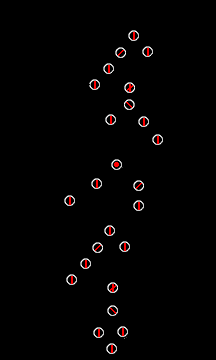
Platoon Column Alpha |
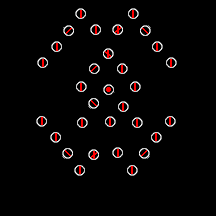 |
| Platoon Column Beta | |
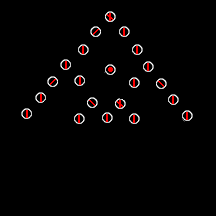 |
|
| Platoon Column Gamma |
(b) Line. It provides good lateral dispersion. In this formation, the platoon can deliver the greatest amount of fire to the front. The platoon leader designates the base squad. The transition from movement techniques to maneuver must be done quickly to attain the initiative.
 |
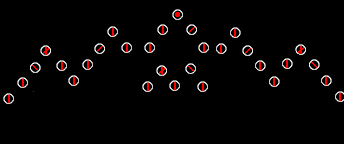 |
| Platoon Line Alpha | Platoon Line Beta |
Remember, just because a
platoon is one formation, it does not preclude the individual
squads in that platoon from using different formations. For
example, the platoon may be organized in a line formation,
while each squad is in column formation, and each fire
team is in a wedge. (see below) This total
formation is traditionally used for an attack on a dug-in foe
with possible flanking units. It is vulnerable to large
Ordinance weapons.
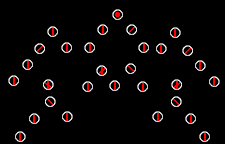 |
| Platoon Line Gamma |
Also remember that the MISSION or the TERRAIN might make platoon formations undesirable. There is rarely a circumstance where squad formations are undesirable.
++++++++++++++++++++
If you need to contact me Lord, send your transmission to Inquisitor Ryjak
Back to the Main
Report
Back to
the Battle Doctrine
+ + + + + +
END TRANSMISSION + + + + + +